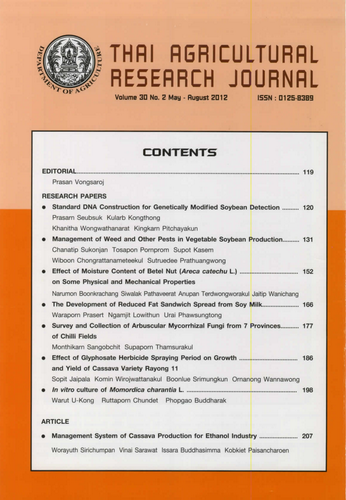Management of Weed and Other Pests in Vegetable Soybean Production
DOI:
https://doi.org/10.14456/thaidoa-agres.2012.11Keywords:
clomazone, gas chromatography mass spectrometry (GC-MS), herbicide residues, metribuzin, pendimethalin, vegetable soybeanAbstract
Management of weed and other pests in vegetable soybean (Glycine max cultivar KPS 292) production to reduce pesticides application, were carried out in the National Corn and Sorghum Research Center. Nakhon Ratchasima province during August, 2008-May, 2009. Investigation of some weed species that can be alternate-hosts of pathogens showed that Mimosa invisa and Cyperus rotundus were infected by Cercospora sp. And Puccinia sp., respectively. However, weed species and weed pathogens were different from each location and cropping season. The efficacy of several pre-emergence herbicides for weed control in vegetable soybean was evaluated. The results showed that tank-mixed metribuzin 56 g ai/rai + pendimethalin 148.5 g ai/rai was the most effective for weed control and gave the highest yield, followed by metribuzin 84 g ai/rai and pendimethalin 165 g ai/rai, respectively. Herbicide used had no effect on vegetable soybean growth throughout the 65 days until the crop harvest. Herbicide residues in the vegetable soybean product were determined using gas chromatography-mass spectrometry (GC-MS) 7 day before harvest and were found to be lower than the maximum residue limits (MRLs< 0.01 ppm). In addition, the integrated pest management namely the management of weed and other pests in vegetable soybean production was conducted to investigate. This study showed that seed treatment with antagonistic bacterial strain KPS46 (100 ml/ seed 1 kg) plus imidacloprid 70% WS (2 g/ seed 1 kg) followed by foliage spray by antagonistic bacteria Bacillus amyloliquefaciens strain KPS46 (250 ml/ H2O 15 l) at 14-day interval 3-sprays, 2-sprays with combined of algae extract (30 ml/ H2O 20 l) and CaB (20 ml/ H2O 20 l) plus insecticide spraying to control insect pests when their population increasing to action threshold neem extract (100 ml/H2O 80 l) once a week at 50 days after planting had the highest efficiency for other pests control in vegetable soybean production and obtained the highest marketable yield with 1,484 kg/rai
Downloads
Published
How to Cite
Issue
Section
License
Copyright (c) 2017 วารสารวิชาการเกษตร (Thai Agricultural Research Journal)

This work is licensed under a Creative Commons Attribution-NonCommercial-NoDerivatives 4.0 International License.
Thai Agricultural Research Journal



